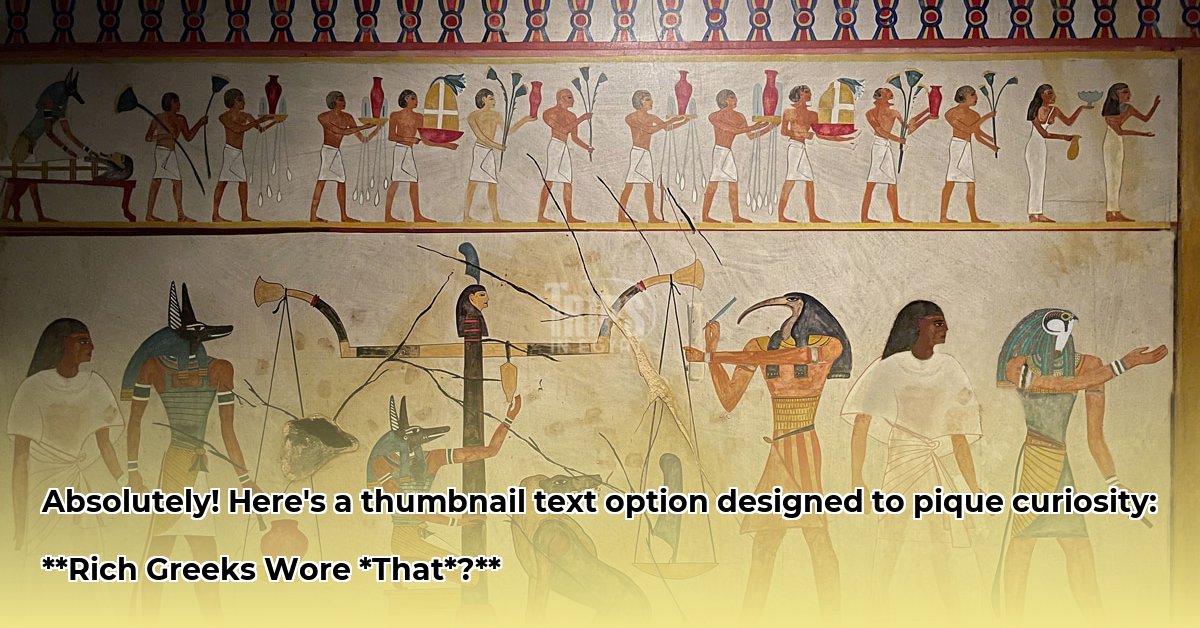Forget the stark white marble of statues you often see; ancient Greece was a vibrant tapestry of colors and textures, especially when it came to the clothing of its elite. Far from being merely functional, ancient Greek attire served as a sophisticated visual language, silently broadcasting a person’s formidable wealth, elevated social standing, and profound cultural integration. The role of women was also reflected in their garments. This article delves beyond the common perceptions to uncover the surprising trends and luxurious details that allowed the super-rich to conspicuously flaunt their opulence during the Golden Age. From unbelievably expensive silks and dazzling dyes to meticulously crafted jewelry and bespoke footwear, every element was carefully chosen to shout, “I am important!” Prepare to unravel the intricate secrets behind ancient Greek fashion, where even the most minute details could dramatically signify social standing and paint a vivid picture of an individual’s opulent life.
Ancient Greek Attire: A Visual Language of Status and Power
Ancient Greek clothing transcended mere modesty; it was a potent non-verbal communicator, instantly signaling an individual’s precise place within society. Consider it an elaborate, walking social profile where fabric quality, color vibrancy, and intricate embellishments served as direct indicators of status, far more impactful than modern-day likes or followers. Even the most fundamental garments – the chiton (a versatile tunic), peplos (a stately draped dress), and himation (a grand cloak) – had opulent versions specifically designed to exclaim, “I am wealthy!” This rich, interwoven tapestry of fashion offers invaluable insights into the complex social stratification and the daily rhythms of elite life in the ancient world.
The Versatile Chiton: More Than Basic Utility
The chiton, a deceptively simple tunic, formed the foundational layer of almost every ancient Greek’s wardrobe, irrespective of gender or age. Yet, the subtle nuances, particularly its length, material, and how it was styled, conveyed profound messages about the wearer’s social standing and occupation. Men, often engaged in public life, military service, or physical labor, typically wore knee-length chitones. This shorter form offered greater freedom of movement, symbolizing active participation in civic or martial duties. Women, by contrast, customarily wore ankle-length chitones, a style often interpreted by historians as reflecting their primary role within the domestic sphere, emphasizing modesty and grace. The choice between Doric and Ionic styles also signaled distinctions. The Doric chiton, simpler and made of wool, was folded around the body and pinned at the shoulders, often leaving one side open below the waist. The Ionic chiton, made of finer, wider linen, was often sewn along the side and pinned or buttoned extensively down the arms, creating a sleeve-like effect, suggesting more leisure and requiring more fabric. Such a seemingly minor difference in length or construction could eloquently convey a person’s life experiences and responsibilities within Greek society.
Peplos Perfection: Embodying Female Elegance and Affluence
The peplos, another elegantly draped garment, gained particular popularity among women, especially the elite. Crafted from a heavier, rectangular piece of cloth than the chiton (often wool), its design prioritized comfort, adjustability, and a striking balance between aesthetic appeal and societal decorum. For aristocratic women, the peplos was frequently layered over a fine chiton, creating a multi-layered appearance that added volume and grandeur. A distinctive feature was the apoptygma – a folded-down top edge that extended halfway down the body, creating the illusion of a second, shorter layer. This fold could be adjusted for temperature or simply for personal style, demonstrating a wearer’s discerning taste and the ample fabric at their disposal. Depictions of aristocratic Greek women in art and statuary often showcase this bloused peplos, frequently ornamented with elaborate borders and rich colors, clearly distinguishing them from common women who wore plainer, undyed versions. The monumental Caryatid columns on the Erechtheion at the Athenian Acropolis famously depict maidens wearing the bloused peplos, underscoring its association with noble femininity.
The Himation: A Cloak of Status and Philosophic Grace
The himation, a substantial and versatile outer garment, functioned as much more than just a cloak; it was a commanding billboard for displaying wealth and social prestige. Typically a large rectangle of fabric, often five yards long and one yard wide, it was worn draped over one shoulder and wrapped around the body. For the truly affluent, the quality of the fabric and the mastery with which it was draped spoke volumes. A heavier, more luxurious himation, expertly arranged to showcase its vast amount of fabric, fine weave, and weighted corners (sometimes with tassels or beads), strongly implied a life of leisure, far removed from manual labor. While worn by both sexes, women often used a version with a pleated upper edge attached to a band, frequently associated with goddesses like Athena or noble queens, due to its sculptural qualities. This versatile garment could be worn in myriad ways – as a cape, a full robe, or even a blanket in colder months, as ancient Greece, particularly in winter, could be surprisingly chilly. Philosophers, in particular, were known for wearing plainer himations as their sole outer garment, signaling intellectual focus over material display, yet even their choice subtly communicated their identity. The iconic image of King Leonidas I in the film 300 wearing his striking red himation further cemented this garment’s association with power and leadership in the modern imagination.
The Chlamys: A Symbol of Youth, Valor, and Freedom
The chlamys, a shorter, practical cloak, was predominantly favored by young men, soldiers, and travelers. More than just a piece of clothing, it served as a powerful symbol of youthful vigor, martial prowess, and readiness for action. Fastened at the right shoulder, it allowed the left arm to move freely, making it ideal for carrying a shield or weapon. This garment was the pragmatic choice for those engaged in athletic pursuits, military campaigns, or long journeys on horseback. Its adoption as the typical military outfit from the 5th to 3rd centuries BCE meant it became synonymous with bravery and strength. For young, active men, it was often the sole item of clothing worn over a loincloth or short chiton, highlighting their athleticism and unburdened freedom – a stark contrast to the more voluminous and restrictive garments of older, sedentary elites.
The Fabric of Affluence: Textiles, Dyes, and Exquisite Embellishments
For the ancient Greek elite, the material of their clothing was paramount, a direct proclamation of their status. Wealthy Greeks conspicuously displayed their riches through the abundant use of sumptuously soft, high-quality wool and, crucially, imported linen. These materials were not only significantly more comfortable and aesthetically pleasing but also far more luxurious than the coarser, locally produced options available to the vast majority. The texture, sheen, and very feel of one’s clothes could thus speak volumes about one’s financial standing long before a single word was uttered.
Fabric Finesse: Linen, Wool, and the Ascendancy of Silk
Linen, meticulously crafted from the versatile flax plant, was prized for its lightweight, airy feel, making it the ideal choice for Greece’s hot Mediterranean summers. The Greeks were adept at flax cultivation, employing varied harvesting methods to produce different qualities of linen, from crisp and lightweight weaves to more substantial, flowing textures. Wool, sourced from the plentiful sheep flocks across Greece, provided essential insulation and warmth, with its density varying depending on the weave. Sheep were fundamental to the Greek economy, valued for their fleece, skins, and as a food source.
However, as robust trade networks flourished, particularly during the Hellenistic period following Alexander the Great’s conquests, exotic fabrics began to trickle into the Greek world from the East. Silk, a truly luxurious import primarily from distant China, emerged as the ultimate symbol of elite status and cosmopolitan taste. Its unparalleled softness, ethereal shimmer, and exotic origins instantly set its wearers apart from the crowd. The island of Cos also gained renown for producing a lighter, more transparent type of silk, reputedly introduced by Pamphile, further diversifying the luxurious textile market available to the elite. In stark contrast, ordinary citizens typically wore garments made from plain, undyed, and often rougher fabrics, almost exclusively local wool or basic linen. The presence of silk, often reserved for courtly attire, became a definitive marker of the highest echelons of society.
The Power of Pigment: Dyes That Defined Status
Beyond the sheer quality of the materials, color played an extraordinarily crucial role in signaling immense wealth. The most coveted and expensive color was undoubtedly Tyrian purple, a rich hue derived through an incredibly laborious process from the internal glands of thousands of murex snails (a type of sea mollusk). The sheer scarcity and difficulty of extraction—requiring an astonishing 10,000 to 12,000 snails to produce just over one gram of dye—made purple fabric extraordinarily expensive. This exorbitant cost unequivocally signaled immense wealth, solidifying its status as the color of royalty, religious authority, and the ultra-rich.
Beyond purple, vibrant shades like saffron yellow or madder root red, achieved through other complex natural dyeing processes, also signified prosperity and access to highly skilled artisans. While the modern claim that blue was unknown in the Mediterranean after the Bronze Age Collapse is inaccurate (Egyptian and Minoan art clearly show blue in use), its production method was not evident in the Archaic or Classical Greek periods, meaning blue garments were not typically depicted. Nevertheless, an elite individual strolling through the agora (the bustling public square) draped in a garment dyed a vibrant, costly purple or a rich, deep red would instantly command respect and admiration, making an undeniable statement of their substantial fortune. White, the natural color of linen and wool, remained common for ordinary citizens, further highlighting the distinction.
Elaborate Embellishments: A Touch of Opulence
The display of wealth extended beyond just the fabric and its dye; intricate details mattered immensely. Elaborate embellishments, such as intricate embroidery, the skillful incorporation of gold thread, and woven patterns, elevated garments to unprecedented heights of luxury. These were not the casual outfits of everyday life; they were meticulously crafted statements of opulence, demonstrating that a significant investment of both wealth and artistic skill was poured into their creation. The kore statues, for instance, famously depict the exquisitely woven patterns and decorative borders that some wealthy individuals sported to distinguish themselves. These embellishments often reflected profound cultural values, with patterns frequently inspired by nature, complex mythological scenes, or precise geometric designs like the meander (Greek key) motif, symbolizing unity and continuity. Only the wealthiest could commission such bespoke artistry, further setting their attire apart.
Adorning the Elite: Footwear, Jewelry, and Personal Styling
The comprehensive display of wealth extended beyond the primary garments, encompassing every minute detail from footwear to personal adornments. This holistic approach to presentation ensured that no element was overlooked in communicating one’s elevated social standing and refined taste.
Footwear Finesse: Beyond Simple Sandals
Footwear in ancient Greece generally leaned towards minimalism, with simple sandals being the standard for the majority. However, the wealthy could afford and flaunted far more elaborate designs. These premium sandals or shoes were crafted with intricate metalwork, luxurious, supple leather, and often featured carved motifs or embellishments. While the basic form might have been similar, the sophistication of materials, the refined craftsmanship, and the decorative elements in elite footwear were undeniable, clearly setting them apart from the common folk who wore basic, unadorned leather carbatines. Full boots, known as cothurnus, made of leather with thicker soles and often red straps, were worn during colder weather or for travel and specific professions like horse riding, further indicating the wearer’s means.
Jewelry as a Multifaceted Statement: Gold, Silver, and Gemstones
Jewelry, including an array of earrings, bracelets, necklaces, and rings, provided another crucial avenue for conspicuously displaying wealth. These magnificent adornments frequently depicted gods, goddesses, or intricate mythological scenes, meticulously crafted from precious metals like gleaming gold and lustrous silver, sometimes inlaid with vibrant semi-precious stones. The sheer artistry, the quality of workmanship, and the inherent value of the materials used in these pieces added another profound layer of status, signaling not just immense wealth but also refined taste, cultural knowledge, and profound piety. These valuable items were often treasured and passed down through generations, becoming significant family heirlooms and symbols of enduring lineage.
Hairstyles, Cosmetics, and Hats: The Finishing Touches of Privilege
How did wealthy Greeks further elevate their overall appearance? Elaborate hairstyles, often meticulously maintained and styled by
- Unearth ancient rome achievements: Engineering feats & legal legacies, examined - August 13, 2025
- Unlock ancient rome army ranks: Power, impact & legion command - August 13, 2025
- Conquer Your Exam: Ancient Greece Quiz Ace It Now! - August 13, 2025





![Unveiling Ancient [black people in ancient greece]: New Civilizations Insights, Challenging History black_people_in_ancient_greece_edited](https://www.lolaapp.com/wp-content/uploads/2025/08/black_people_in_ancient_greece_edited-150x150.jpg)










